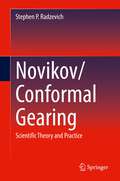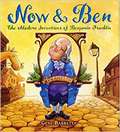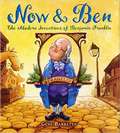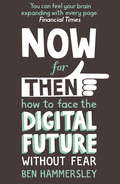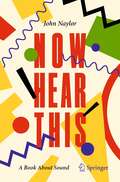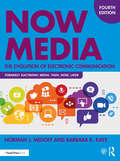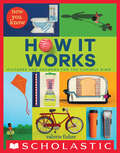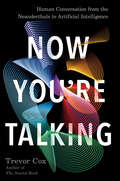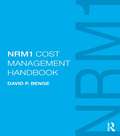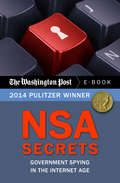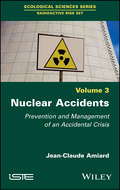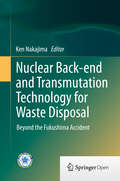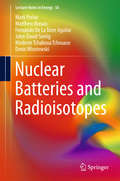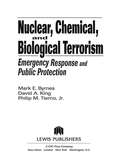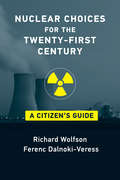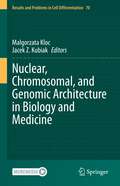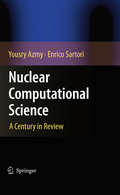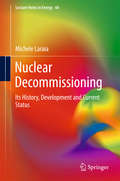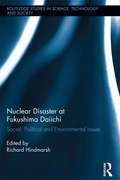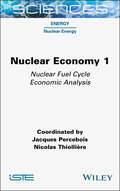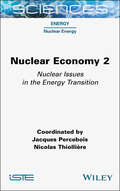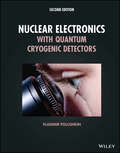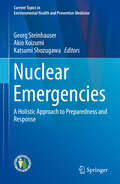- Table View
- List View
Novikov/Conformal Gearing: Scientific Theory and Practice
by Stephen P. RadzevichThis book presents the latest accomplishments in Novikov/conformal gearing as well as high-conformal gearing. It is focused primarily on strength calculation of gear teeth and the manufacturing of gears for Novikov/conformal and high-conformal gearing along with a brief discussion of achievements in the modern theory of gearing. The modern theory of gearing is the foundation of all optimal designs of gears, gear-sets, and transmissions of all known designs, as well as, of all those to be developed in the future. As even a small improvement in efficiency on a single gear can represent a significant cost saving, given the millions of gears used in industry every year, this volume provides the design and manufacturing engineer in invaluable resource.
Now & Ben: The Modern Inventions Of Benjamin Franklin
by Gene BarrettaThe inventions and inspiration of Benjamin Franklin and how they've stood the test of time. What would you do if you lived in a community without a library, hospital, post office, or fire department? If you were Benjamin Franklin, you'd set up these organizations yourself. Franklin also designed the lightning rod, suggested the idea of daylight savings time, and invented bifocals-all inspired by his common sense and intelligence. In this informative book, Gene Barretta brings Benjamin Franklin's genius to life, deepening our appreciation for one of the most influential figures in American history.
Now & Ben: The Modern Inventions Of Benjamin Franklin
by Gene BarrettaNIMAC-sourced textbook <p><p> What would you do if you lived in a community without a library, hospital, post office, or fire department? If you were Benjamin Franklin, you'd set up these organizations yourself. Franklin also designed the lightning rod, suggested the idea of daylight savings time, and invented bifocals-all inspired by his common sense and intelligence. In this informative book, Gene Barretta brings Benjamin Franklin's genius to life, deepening our appreciation for one of the most influential figures in American history.
Now For Then: How To Face The Digital Future Without Fear
by Ben HammersleyIn 64 THINGS YOU NEED TO KNOW NOW FOR THEN, Editor-at-Large for Wired magazine and guru of the digital age Ben Hammersley gives us the essential guide to the things we need to know for life in the 21st century. Explaining the effects of the changes in the modern world, and the latest ideas in technology, culture, business and politics, this book will demystify the internet, decode cyberspace, and guide you through the innovations of the revolution we are all living through. This is not a book for geeks. 64 THINGS YOU NEED TO KNOW NOW FOR THEN is for everyone who wants to truly understand the modern world, to no longer be confused by the changes in society, business and culture, and to truly prosper in the coming decade.
Now For Then: How to Face the Digital Future Without Fear
by Ben HammersleyIn 64 THINGS YOU NEED TO KNOW NOW FOR THEN, Editor-at-Large for Wired magazine and guru of the digital age Ben Hammersley gives us the essential guide to the things we need to know for life in the 21st century. Explaining the effects of the changes in the modern world, and the latest ideas in technology, culture, business and politics, this book will demystify the internet, decode cyberspace, and guide you through the innovations of the revolution we are all living through. This is not a book for geeks. 64 THINGS YOU NEED TO KNOW NOW FOR THEN is for everyone who wants to truly understand the modern world, to no longer be confused by the changes in society, business and culture, and to truly prosper in the coming decade.
Now Hear This: A Book About Sound
by John NaylorThis book explains the nature of sound both as a physical phenomenon and as a sensation, how it travels through air and water, and how the hearing system evolved to convert these vibrations into sensations. Drawing on physics, biology, neuroscience, philosophy, literature, history, anecdote, and personal experience, "Now Hear This" is a wide-ranging exploration of the nature of sound and hearing that opens up a fascinating world of sounds from the mundane to the unusual and seeks above all to persuade the reader of the wisdom of John Cage’s advice that “Wherever we are what we hear is mostly noise. When we ignore it, it disturbs us. When we listen to it, we find it fascinating.”
Now Media: The Evolution of Electronic Communication
by Norman J. Medoff Barbara K. KayeNow in its fourth edition, this book is one of the leading texts on the evolution of electronic mass communication in the last century, giving students a clear understanding of how the media of yesterday shaped the media world of today. Now Media, Fourth Edition (formerly Electronic Media: Then, Now, Later) provides a comprehensive view of the beginnings of electronic media in broadcasting and the subsequent advancements into ‘now’ digital media. Each chapter is organized chronologically, starting with the electronic media of the past, then moving to the media of today, and finally, exploring the possibilities for the media of the future. Topics include the rise of social media, uses of personal communication devices, the film industry, and digital advertising, focusing along the way on innovations that laid the groundwork for ‘now’ television and radio and the Internet and social media. New to the fourth edition is a chapter on the amazing world of virtual reality technology, which has spawned a ‘now’ way of communicating with the world and becoming a part of video content, as well as a discussion of the impacts of the COVID-19 pandemic on media consumption habits. This book remains a key text and trusted resource for students and scholars of digital mass communication and communication history alike. The new ‘now’ edition also features updated online instructor materials, including PowerPoint slides and test banks. Please visit www.routledge.com/cw/medoff to access these support materials.
Now You Know: Pictures and Answers for the Curious Mind
by Valorie FisherExplore the mechanics of everyday things like toasters, toilets and kites with fun and simple infographics sure to change how a reader views the world.Valorie Fisher takes infographics to a new level with bright, colorful visuals that are perfect for young, inquisitive minds. Her eye-catching mix of photographs and illustrations compels readers to dive in and explore how things work—from paper airplanes to straws, crayons to kites, pencils to boats.This book will answer questions kids have long wanted answers to and go on to answer questions they didn’t even know they had! Do you know why your shadow changes shape throughout the day? Do you know how a whistle makes that trilling sound? How about why a rubber ball bounces? All these questions and more are explained in this exciting book, the first of two in the Now You Know series.With the growing focus on STEM for this early age group, Now You Know: How It Works is perfectly timed to reach that early reader and instill a love of STEM from day one.Praise for Now You Know: How It WorksA Junior Library Guild Selection“A bright and stimulating introduction to the mechanics and makeup of everyday objects and phenomena . . . An engaging and visually tempting starting point to prepare kids for more in-depth titles like David Macaulay’s The Way Things Work Now.” —School Library Journal“This educational guide introduces the mechanics behind familiar objects, machines, and physical phenomena . . . Fisher introduces complex concepts concisely while gently suggesting to readers that there is a world of knowledge to be discovered in everyday things.” —Publishers Weekly
Now You See It
by Davidson Cathy N.When Cathy Davidson and Duke University gave free iPods to every member of the incoming freshman class in 2003, they didn't expect the uproar that followed. Critics called it a waste: What educational value could a music player have for college kids? Yet by the end of the year, Duke students had found academic uses for the new devices in virtually every discipline. The iPod experiment proved to be a classic example of the power of disruption -- a way of refocusing attention to illuminate unseen possibilities. Using cutting-edge research on the brain, Davidson shows how the phenomenon of "attention blindness" shapes our lives, and how it has led to one of the greatest problems of our historical moment: Although we blog, tweet, and text as if by instinct, far too many of us still toil in schools and workplaces designed for the last century, not the one we live in. To change this, we must ask ourselves critical questions: How can we redesign our schools to prepare our kids for the challenges they'll face as adults? What will the workers and workplaces of the future look like? And how can we learn to adapt to life changes that seem almost too revolutionary to contemplate?Davidson takes us on a tour of the future of work and education, introducing us to visionaries whose groundbreaking ideas will soon affect us all. Now You See It opens a window onto the possibilities of a world in which the rigid ideas of the twentieth century have been wiped away and replaced with the flowing, collaborative spirit built into the very design of the Internet.
Now You're Talking: Human Conversation from the Neanderthals to Artificial Intelligence
by Trevor CoxA history of how humans developed our capacity for conversation—and what might happen now that computers are catching up.Trevor Cox has been described by The Observer as ""a David Attenborough of the acoustic realm."" In Now You're Talking, he takes us on a journey through the wonders of human speech, starting with the evolution of language and our biological capability to speak (and listen), and bringing us up to date with the latest computer technology.Language is what makes us human, and how we speak is integral to our personal identity. But with the invention of sound recording and the arrival of the electrified voice, human communication changed forever; now advances in computer science and artificial intelligence are promising an even greater transformation. And with it come the possibilities to reproduce, manipulate, and replicate the human voice—sometimes with disturbing consequences.Now You're Talking is the fascinating story of our ability to converse. It takes us back to the core of our humanity, asking important questions about what makes us human and how this uniqueness might be threatened. On this illuminating tour we meet vocal coaches and record producers, neuroscientists and computer programmers, whose experience and research provide us with a deeper understanding of something that most of us take for granted—our ability to talk and listen.
NRM1 Cost Management Handbook
by David P BengeThe definitive guide to measurement and estimating using NRM1, written by the author of NRM1 The 'RICS New rules of measurement: Order of cost estimating and cost planning of capital building works' (referred to as NRM1) is the cornerstone of good cost management of capital building works projects - enabling more effective and accurate cost advice to be given to clients and other project team members, while facilitating better cost control. The NRM1 Cost Management Handbook is the essential guide to how to successfully interpret and apply these rules, including explanations of how to: quantify building works and prepare order of cost estimates and cost plans use the rules as a toolkit for risk management and procurement analyse actual costs for the purpose of collecting benchmark data and preparing cost analyses capture historical cost data for future order of cost estimates and elemental cost plans employ the rules to aid communication manage the complete 'cost management cycle' use the elemental breakdown and cost structures, together with the coding system developed for NRM1, to effectively integrate cost management with Building Information Modelling (BIM). In the NRM1 Cost Management Handbook, David Benge explains in clear terms how NRM1 is meant to be used in familiar quantity surveying tasks, as well as a range of activities of crucial importance for professionals in years to come. Worked examples, flow charts, diagrams, templates and check lists ensure readers of all levels will become confident and competent in the use of NRM1. This book is essential reading for anyone working with NRM1, and is the most authoritative guide to practice available for those preparing to join the industry.
NSA Secrets: Government Spying in the Internet Age
by The Washington PostThe Pulitzer Prize–winning investigation into surveillance abuses and the Edward Snowden case that brought them to light. The NSA's extensive surveillance program has led Americans to question threats to their privacy. As reported by the Washington Post, in their Pulitzer Prize-winning coverage of whistleblower Edward Snowden's NSA leaks, NSA Secrets delves into the shadowy world of information gathering, exposing how data about you is being collected every day. From his earliest encrypted exchanges with reporters, Edward Snowden knew he was a man in danger. Sitting on a mountain of incriminating evidence about the NSA surveillance programs, Snowden was prepared to risk his freedom, and his very life, to let the world know about the perceived overreach of the NSA and the massive collection of personal information that was carried out in the name of national security by the U.S. government. The Washington Post&’s complete coverage of the NSA spying scandal, which it helped break, is now collected in one place to give as comprehensive a view of the story as is known. From the first contact with Snowden to the latest revelations in worldwide cellphone tracking, the award-winning reporters at the Post have vigorously reported on the scope of the NSA&’s surveillance. Snowden called the internet &“a TV that watches you,&” and accused the government of &“abusing [it] in secret to extend their powers beyond what is necessary and appropriate.&” Here, the secrets of those who tried in vain to remain in the shadows are revealed.
Nuclear Accidents: Prevention and Management of an Accidental Crisis
by Jean-Claude AmiardDetailing the estimation and perception of nuclear risk, this book follows military and civilian nuclear accidents, plus the systems put in place by national and international authorities for recording and analyzing feedback. Prevention and anticipation being the best defenses against a nuclear accident, the authorities have also categorized the different types of accidents, and are doing research to better understand and control them. In light of this, this book shows how the authorities take practical measures to protect neighboring populations and limit radioactive contamination of the environment. France's experience in this arena is well-documented and a chapter of this book is devoted to the fight against terrorist attacks in the nuclear field. Nuclear Accidents is based on scientifically-recognized publications, as well as on reports from the various countries concerned, and the national and international organizations competent in this field (IAEA, WHO, UNSCEAR, IRSN, etc.).
Nuclear Back-end and Transmutation Technology for Waste Disposal
by Ken NakajimaThis book covers essential aspects of transmutation technologies, highlighting especially the advances in Japan. The accident at the Fukushima Daiichi Nuclear Power Plant (NPP) has caused us to focus attention on a large amount of spent nuclear fuels stored in NPPs. In addition, public anxiety regarding the treatment and disposal of high-level radioactive wastes that require long-term control is growing. The Japanese policy on the back-end of the nuclear fuel cycle is still unpredictable in the aftermath of the accident. Therefore, research and development for enhancing the safety of various processes involved in nuclear energy production are being actively pursued worldwide. In particular, nuclear transmutation technology has been drawing significant attention after the accident. This publication is timely with the following highlights: 1) Development of accelerator-driven systems (ADSs), which is a brand-new reactor concept for transmutation of highly radioactive wastes; 2) Nuclear reactor systems from the point of view of the nuclear fuel cycle. How to reduce nuclear wastes or how to treat them including the debris from TEPCO's Fukushima nuclear power stations is discussed; and 3) Environmental radioactivity, radioactive waste treatment and geological disposal policy. State-of-the-art technologies for overall back-end issues of the nuclear fuel cycle as well as the technologies of transmutation are presented here. The chapter authors are actively involved in the development of ADSs and transmutation-related technologies. The future of the back-end issues in Japan is very uncertain after the accident at the Fukushima Daiichi NPP and this book provides an opportunity for readers to consider the future direction of those issues.
Nuclear Batteries and Radioisotopes
by Mark Prelas Matthew Boraas Fernando De La Torre Aguilar John-David Seelig Modeste Tchakoua Tchouaso Denis WisniewskiThis book explains the physics of nuclear battery operation. It provides a comprehensive background that allows readers to understand all past and future developments in the field. The supply and cost of radioisotopes for use in applications (focused on nuclear batteries) are covered in the initial sections of the text. The interaction of ionizing radiation with matter is discussed as applied to nuclear batteries. The physics of interfacing the radioisotopes to the transducers which represent the energy conversion mechanism for nuclear batteries are described for possible nuclear battery configurations. Last but not least the efficiencies of nuclear battery configurations are discussed combined with a review of the literature on nuclear battery research.
Nuclear, Chemical, and Biological Terrorism: Emergency Response and Public Protection
by Mark E. Byrnes David A. King Philip M. Tierno Jr.This book provides guidance on measures that should be considered to protect human lives from terrorist activities involving nuclear, chemical, and biological weapons. It provides a historical summary of the development and use of these weapons, and continues with a detailed discussion of the types of radiation and warfare agents that are available
Nuclear Choices for the Twenty-First Century: A Citizen's Guide
by Richard Wolfson Ferenc Dalnoki-VeressAn authoritative and unbiased guide to nuclear technology and the controversies that surround it.Are you for nuclear power or against it? What's the basis of your opinion? Did you know a CT scan gives you some 2 millisieverts of radiation? Do you know how much a millisievert is? Does irradiation make foods safer or less safe? What is the point of a bilateral Russia-US nuclear weapons treaty in a multipolar world? These are nuclear questions that call for nuclear choices, and this book equips citizens to make these choices informed ones. It explains, clearly and accessibly, the basics of nuclear technology and describes the controversies surrounding its use.
Nuclear, Chromosomal, and Genomic Architecture in Biology and Medicine (Results and Problems in Cell Differentiation #70)
by Malgorzata Kloc Jacek Z. KubiakThis volume reviews the latest research on the functional implications of nuclear, chromosomal and genomic organization and architecture on cell and organismal biology, and development and progression of diseases.The architecture of the cell nucleus and non-random arrangement of chromosomes, genes, and the non-membranous nuclear bodies in the three-dimensional (3D) space alters in response to the environmental, mechanical, chemical, and temporal cues. The changes in the nuclear, chromosomal, or genomic compaction and configuration modify the gene expression program and induce or inhibit epigenetic modifications. The intrinsically programmed rearrangements of the nuclear architecture are necessary for cell differentiation, the establishment of cell fate during development and maturation of tissues and organs including the immune, muscle, and nervous systems.The non-programmed changes in the nuclear architecture can lead to fragmentation of the nucleus and instability of the genome and thus cause cancer. Microbial and viral infections can lead to a clustering of centromeres, telomeres and ribosomal DNA and alter the properties of the nuclear membrane, allowing large immobile macromolecules to enter the nucleus. Recent advances in next-generation sequencing technologies combined with nucleus/chromosome conformation capture, super-resolution imaging, chromosomal contact maps methods, integrative modeling, and genetic approaches, are uncovering novel features and importance of nuclear, chromosomal and genomic architecture. This book is an interesting read for cell biologists, researchers studying the structure and function of chromosomes, and anyone else who wants to get an overview of the field of nuclear, chromosomal and genomic architecture.
Nuclear Computational Science
by Yousry Azmy Enrico SartoriNuclear engineering has undergone extensive progress over the years. In the past century, colossal developments have been made and with specific reference to the mathematical theory and computational science underlying this discipline, advances in areas such as high-order discretization methods, Krylov Methods and Iteration Acceleration have steadily grown. Nuclear Computational Science: A Century in Review addresses these topics and many more; topics which hold special ties to the first half of the century, and topics focused around the unique combination of nuclear engineering, computational science and mathematical theory. Comprising eight chapters, Nuclear Computational Science: A Century in Review incorporates a number of carefully selected issues representing a variety of problems, providing the reader with a wealth of information in both a clear and concise manner. The comprehensive nature of the coverage and the stature of the contributing authors combine to make this a unique landmark publication. Targeting the medium to advanced level academic, this book will appeal to researchers and students with an interest in the progression of mathematical theory and its application to nuclear computational science.
Nuclear Decommissioning: Planning, Execution And International Experience (Woodhead Publishing Series In Energy Ser.)
by Michele LaraiaThis book discusses the history of nuclear decommissioning as a science and industry. It explores the early, little-known period when the term “decommissioning” was not used in the nuclear context and the end-of-life operations of a nuclear facility were a low priority. It then describes the subsequent period when decommissioning was recognized as a separate phase of the nuclear lifecycle, before bringing readers up to date with today’s state of the art.The author addresses decommissioning as a mature industry in an era in which large, commercial nuclear reactors and other fuel-cycle installations have been fully dismantled, and their sites returned to other uses. The book also looks at the birth, growth and maturity of decommissioning, focusing on how new issues emerged, how these were gradually addressed, and the lessons learned from them. Further, it examines the technologies and management advances in science and industry that followed these solutions. Nuclear Decommissioning is a point of reference for industry researchers and decommissioning practitioners looking to enrich their knowledge of decommissioning in recent decades as well as the modern industry. The book is also of interest to historians and students who wish to learn more about the history of nuclear decommissioning.
Nuclear Disaster at Fukushima Daiichi: Social, Political and Environmental Issues (Routledge Studies in Science, Technology and Society)
by Richard HindmarshNuclear Disaster at Fukushima Daiichi is a timely and groundbreaking account of the disturbing landscape of the Fukushima Daiichi nuclear meltdown amidst an earthquake and tsunami on Japan’s northeast coastline on March 11, 2011. It provides riveting insights into the social and political landscape of nuclear power development in Japan, which significantly contributed to the disaster; the flawed disaster management options taken; and the political, technical, and social reactions as the accident unfolded. In doing so, it critically reflects on the implications for managing future nuclear disasters, for effective and responsible regulation and good governance of controversial science and technology, or technoscience, and for the future of nuclear power itself, both in Japan and internationally. Informed by a leading cast of international scholars in science, technology and society studies, the book is at the forefront of discussing the Fukushima Daiichi disaster at the intersection of social, environmental and energy security and good governance when such issues dominate global agendas for sustainable futures. Its powerful critique of the risks and hazards of nuclear energy alongside poor disaster management is an important counterbalance to the plans for nuclear build as central to sustainable energy in the face of climate change, increasing extreme weather events and environmental problems, and diminishing fossil fuel, peak oil, and rising electricity costs. Adding significantly to the consideration and debate of these critical issues, the book will interest academics, policy-makers, energy pundits, public interest organizations, citizens and students engaged variously with Fukushima itself, disaster management, political science, environmental/energy policy and risk, public health, sociology, public participation, civil society activism, new media, sustainability, and technology governance.
Nuclear Economy 1: Nuclear Fuel Cycle Economic Analysis
by Jacques Percebois Nicolas ThiollièreThis book presents the factual, precise, complete and accessible economic elements of nuclear energy in order to contribute to an informed and dispassionate debate. It begins with an in-depth analysis of the strategic policies relating to nuclear energy in France and around the world. The methodological aspects are presented exhaustively and illustrated with detailed examples and case studies. This book provides a relevant economic study of the fuel component of nuclear energy. In this context, aspects of the uranium market are presented, before describing in detail the technical and economic components upstream of the nuclear cycle.
Nuclear Economy 2: Nuclear Issues in the Energy Transition
by Jacques Percebois Nicolas ThiollièreThis book presents the factual, precise, complete and accessible economic elements of nuclear energy in order to contribute to an informed and dispassionate debate. It analyzes the economic aspects of spent fuel management, including the costs and financing of long-term storage and deep geological disposal. The economic costs of a nuclear accident are also discussed from both theoretical and applied angles, based on the Fukushima nuclear disaster. Nuclear Economy 2 also examines the industrial and political aspects of the future energy mix. Nuclear energy is thus placed in the more global context of the European electricity market. Finally, this book offers a panorama of energy scenarios on the scale of France, but also of the world.
Nuclear Electronics with Quantum Cryogenic Detectors
by Vladimir PolushkinNUCLEAR ELECTRONICS WITH QUANTUM CRYOGENIC DETECTORS An ideal, comprehensive reference on quantum cryogenic detector instrumentation for the semiconductor and nuclear electronics industries Quantum nuclear electronics is an important scientific and technological field that overviews the development of the most advanced analytical instrumentation. This instrumentation covers a broad range of applications such as astrophysics, fundamental nuclear research facilities, chemical nano-spectroscopy laboratories, remote sensing, security systems, forensic investigations, and more. In the years since the first edition of this popular resource, the discipline has developed from demonstrating the unprecedented energy resolving power of individual devices to building large frame cameras with hundreds of thousands of pixel arrays capable of measuring and processing massive information flow. Building upon its first edition, the second edition of Nuclear Electronics with Quantum Cryogenic Detectors reflects the latest advances by focusing on novel microwave kinetic inductance detection devices (MKIDs), the microwave superconducting quantum interferometers (MSQUIDs) extending by orders of magnitude the scalability of cryogenic detectors implementing newly developed multiplexing techniques and decoding algorithms. More, it reflects on the interaction of quantum cryogenic detectors—which in turn can be paired with semiconductor large frame cameras to provide a broad picture of a sky or chemical sample—and quantum devices, making this second edition of Nuclear Electronics a one-stop reference for the combined technologies. The book also provides an overview of latest developments in front-end electronics, signal processing channels, and cryogenics—all components of quantum spectroscopic systems—and provides guidance on the design and applications of the future quantum cryogenic ultra-high-resolution spectrometers. Nuclear Electronics with Quantum Cryogenic Detectors readers will also find: Fully revised material from the first edition relating to cryogenic requirements Brand new chapters on semiconductor radiation sensors, cooling and magnetic shielding for cryogenic detector systems; front-end readout electronic circuits for quantum cryogenic detectors; energy resolution of quantum cryogenic spectrometers; and applications of spectrometers based on cryogenic detectors A number of brand-new chapters dedicated to applications using MSQUID multiplexing technique, an area that will dominate the cryogenic detector field in the next decades Nuclear Electronics with Quantum Cryogenic Detectors provides a comprehensive overview of the entire discipline for researchers, industrial engineers, and graduate students involved in the development of high-precision nuclear measurements, nuclear analytical instrumentation, and advanced superconductor primary sensors. It is also a helpful resource for electrical and electronic engineers and physicists in the nuclear industry, as well as specialist researchers or professionals working in cryogenics applications like biomagnetism, quantum computing, gravitation measurement, and more.
Nuclear Emergencies: A Holistic Approach to Preparedness and Response (Current Topics in Environmental Health and Preventive Medicine)
by Georg Steinhauser Akio Koizumi Katsumi ShozugawaThis book discusses nuclear events that may become imminent threats to the fabric of our society, and elucidates strategies for preventing these threats or mitigating their adverse effects. It addresses multidisciplinary aspects of various nuclear emergencies, including nuclear accidents, terror attacks involving nuclear materials, illicit trafficking of nuclear materials, and problems related to nuclear forensics and strikes with nuclear weapons/warheads. Very often, nuclear emergencies are only discussed within certain, specific communities. However, this volume brings together experts from various fields to provide a more holistic approach to the problem. Physical, chemical, environmental, social, and medical scientists, together with representatives from the media and authorities, present their views on and strategies for events that cause fear and anxiety among the public – an aspect that can be even more threatening than the direct health effects. The book offers a valuable guide for nuclear scientists, such as radioecologists, health physicists, radioanalytical scientists and nuclear engineers, as well as decision-makers and national/international authorities.
